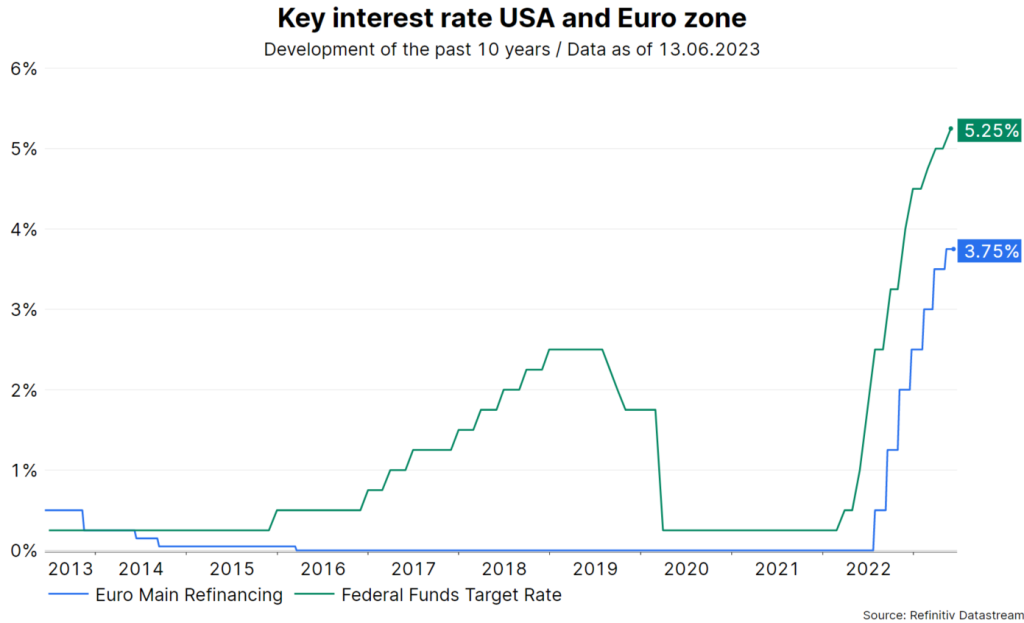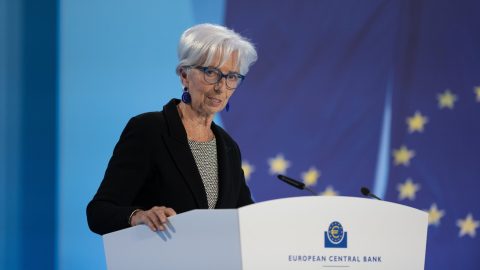This week, the markets are eagerly awaiting the upcoming interest rate decisions: today, Wednesday, the US Federal Reserve begins; tomorrow, Thursday, the European Central Bank (ECB) will follow; and on Friday, the Bank of Japan (BoJ) will update its course.
The central banks would like to take a break from raising key-lending rates to better assess the effects of the previous rate hikes. However, the ongoing high inflation rates make this approach difficult, despite the fact that inflation has recently slowed down somewhat.
Two shocks
The global economy has been confronted by two major shocks, i.e. the pandemic and the war in Ukraine. In the meantime, economic indicators such as gross domestic product and employment have embarked on a process of normalisation. However, this process is extremely slow because of the long-lasting nature of the after-effects of the shocks. High inflation and the tight labour market stand out in particular.
High inflation and low productivity
In addition to the interest rate decisions, another focus this week was on the release of consumer price inflation data in the USA for the month of May. Traditionally, the volatile components of energy and food are excluded to establish the so-called core inflation.
This indicator fell slightly year-on-year from 5.5% in the previous month to 5.3%. A somewhat more pronounced decline to 5.2% had previously been expected. As in the previous month, the month-on-month change was 0.4%. Annualized (0.4% times 12 months), inflation is still far too high to be in line with the central bank’s inflation target of 2%.
In the Eurozone, the release of the Q1 GDP showed a 6.2% year-on-year increase in the overall price level. Both unit labour costs and corporate profits contributed to this situation. At the same time, labour productivity shrank because employment growth outpaced economic growth.
Rate hike pause?
Central banks have responded to this environment with a rapid cycle of interest rate hikes. But real economic growth in the developed world is subdued. In this environment, central banks would like to pause to better assess the lagged effects of rate hikes on growth, employment, income, investment, profits, and ultimately, inflation. This is because uncertainty about the relationship between monetary policy, growth, and inflation is traditionally high.
The medicine is starting to take effect
There are growing signs that the monetary policy “medicine” is beginning to take effect. In particular, bank lending guidelines have become more restrictive. Last week, the Institute for Supply Management’s purchasing managers’ index for the service sector pointed to growth risks in the USA with a drop to stagnation territory (50.3).
At the same time, the second estimate for economic growth in the Eurozone brought a downward revision. Now, real GDP contracted slightly in Q4 2022 and in Q1 2023 (by 0.1% quarter-on-quarter in each case). This development, known as a technical recession, is not an actual recession, but it does point to a difficult environment (stagnation).
What is the central banks’ strategy from here on out?
Inflation momentum is the fly in the ointment. Last week, two central banks, the Reserve Bank of Australia and the Bank of Canada, unexpectedly raised key-lending rates further (Australia to 4.10% and Canada to 4.75%).
This week, as already mentioned, three important monetary policy decisions are on the calendar. For the Fed, no hike is expected for the first time in the current cycle. The upper band for the effective key-lending rate is at 5.25%.
By contrast, statements by ECB members suggest another increase. Market prices reflect an increase in the main refinancing rate from 3.75% to 4.00%. While no rate hike is expected for the Bank of Japan (currently: -0.1%), there is speculation about a further increase in the ceiling for the 10Y government bond yield (currently at 0.5%).

Please note: past performance is no reliable indicator of future development.
Risk management
The central banks are following a risk management approach. Inflation is to be lowered with a restrictive policy. If possible, a recession should be avoided. This is because inflation could fall even without a recession (“immaculate inflation”).
At the same time, the risk of inflation persistence should be kept as low as possible. This means that as long as inflation remains uncomfortably high, central banks will signal a propensity for (and indeed raise) further hikes, even if the growth environment is weak and some indicators point to recession risks. Thus, if the Fed were not to raise rates in June, it would be bold to speak of the end of the hike cycle at that point.
The overall view of growth indicators such as the global purchasing managers’ index for May suggests that the world economy will grow by 2% in the second quarter (annualised). The developed economies will grow at around 1%.
In the most likely scenario, there is thus no immediate recession. This has a directly positive effect on risky securities classes such as equities. That being said, numerous heuristics continue to argue against a “soft” landing of the economy. Only the timing is uncertain.
For a glossary of technical terms, please visit this link: Fund Glossary | Erste Asset Management
Legal note:
Prognoses are no reliable indicator for future performance.
Legal disclaimer
This document is an advertisement. Unless indicated otherwise, source: Erste Asset Management GmbH. The language of communication of the sales offices is German and the languages of communication of the Management Company also include English.
The prospectus for UCITS funds (including any amendments) is prepared and published in accordance with the provisions of the InvFG 2011 as amended. Information for Investors pursuant to § 21 AIFMG is prepared for the alternative investment funds (AIF) administered by Erste Asset Management GmbH pursuant to the provisions of the AIFMG in conjunction with the InvFG 2011.
The currently valid versions of the prospectus, the Information for Investors pursuant to § 21 AIFMG, and the key information document can be found on the website www.erste-am.com under “Mandatory publications” and can be obtained free of charge by interested investors at the offices of the Management Company and at the offices of the depositary bank. The exact date of the most recent publication of the prospectus, the languages in which the fund prospectus or the Information for Investors pursuant to Art 21 AIFMG and the key information document are available, and any other locations where the documents can be obtained are indicated on the website www.erste-am.com. A summary of the investor rights is available in German and English on the website www.erste-am.com/investor-rights and can also be obtained from the Management Company.
The Management Company can decide to suspend the provisions it has taken for the sale of unit certificates in other countries in accordance with the regulatory requirements.
Note: You are about to purchase a product that may be difficult to understand. We recommend that you read the indicated fund documents before making an investment decision. In addition to the locations listed above, you can obtain these documents free of charge at the offices of the referring Sparkassen bank and the offices of Erste Bank der oesterreichischen Sparkassen AG. You can also access these documents electronically at www.erste-am.com.
Our analyses and conclusions are general in nature and do not take into account the individual characteristics of our investors in terms of earnings, taxation, experience and knowledge, investment objective, financial position, capacity for loss, and risk tolerance. Past performance is not a reliable indicator of the future performance of a fund.
Please note: Investments in securities entail risks in addition to the opportunities presented here. The value of units and their earnings can rise and fall. Changes in exchange rates can also have a positive or negative effect on the value of an investment. For this reason, you may receive less than your originally invested amount when you redeem your units. Persons who are interested in purchasing units in investment funds are advised to read the current fund prospectus(es) and the Information for Investors pursuant to § 21 AIFMG, especially the risk notices they contain, before making an investment decision. If the fund currency is different than the investor’s home currency, changes in the relevant exchange rate can positively or negatively influence the value of the investment and the amount of the costs associated with the fund in the home currency.
We are not permitted to directly or indirectly offer, sell, transfer, or deliver this financial product to natural or legal persons whose place of residence or domicile is located in a country where this is legally prohibited. In this case, we may not provide any product information, either.
Please consult the corresponding information in the fund prospectus and the Information for Investors pursuant to § 21 AIFMG for restrictions on the sale of the fund to American or Russian citizens.
It is expressly noted that this communication does not provide any investment recommendations, but only expresses our current market assessment. Thus, this communication is not a substitute for investment advice.
This document does not represent a sales activity of the Management Company and therefore may not be construed as an offer for the purchase or sale of financial or investment instruments.
Erste Asset Management GmbH is affiliated with the Erste Bank and austrian Sparkassen banks.
Please also read the “Information about us and our securities services” published by your bank.



